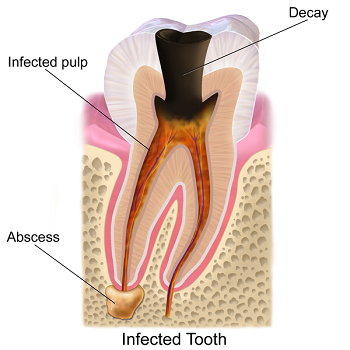Tooth Decay Is the Oldest Disease Known to Man
Nope, it’s not the common cold. Nor is it arthritis, malaria, or leprosy.
According to Healthplex Dental trivia, tooth decay is not only the oldest disease we know of, but also the most common and widespread.
A quick internet search should reveal plenty of claims to the contrary, with even the Guinness Book of World Records getting in on the action proclaiming leprosy appeared prior to tooth decay…

Image via: Blausen.com staff – Wikimedia Commons.
What Is Tooth Decay & How Can We Prevent It?
Tooth decay, which is also called dental cavities or dental caries, is the destruction of the outer surface (enamel) of a tooth.
Decay results from the action of bacteria that live in plaque, which is a sticky, whitish film formed by a protein in saliva (mucin) and sugary substances in the mouth. The plaque bacteria sticking to tooth enamel use the sugar and starch from food particles in the mouth to produce acid.1
How can we keep this cavity coalition at bay? Take it from the CDC:
1. Brush your teeth for 2 minutes, 2x per day.
2. Floss every day.
3. Rinse with mouthwash.
4. Eat a balanced diet Keep your regular dental appointments…lather, rinse, repeat!
Why Do So Many People Have Tooth Decay?
It has been estimated that 90% of people in the United States have at least one cavity, and that 75% of people had their first cavity by the age of five.
More than 25% of American adults ages 20 to 64 have untreated tooth decay, and 91% have one tooth — or more — that has been treated for tooth decay or needs to be. (Source: Time Magazine referencing the CDC report)
Although anyone can have a problem with tooth decay, children and senior citizens are the two groups at highest risk.
Other high-risk groups include people who eat a lot of starchy and sugary foods; people living in areas without a fluoridated water supply; and people who already have numerous dental restorations (fillings and crowns).2
Tooth Decay Prevention is Key
With the cost of dentistry and health insurance limitations sometimes compounding the issue of proper treatment, we can all take a little preventative maintenance.
According to the Medical Dictionary; It is easier and LESS expensive to prevent tooth decay than it is to treat it.
The four major prevention strategies toward thwarting the tooth decay causing cavity creeps in their tracks include:
1. Proper oral hygiene.
2. Flouride.
3. Dental sealants.
4. Attention to diet.
Proper oral hygiene equates keeping our dentist appointments, and brushing twice a day. Throw in some daily flossing and we’re ahead of the game!
Fluoride is a naturally occurring substance that slows the destruction of enamel and helps to repair minor tooth decay damage by remineralizing tooth structure. Toothpaste, mouthwash, fluoridated public drinking water, and vitamin supplements are all possible sources of fluoride.3
Dental sealants are a thin plastic coating that is painted over the grooves of chewing surfaces to prevent food and plaque from being trapped there. They cost less than fillings and can last up to 10 years, although they should be checked for wear at every (regular) dental visit.
As Americans, we can all probably use a little help on the diet. Big Macs and super sized sodas taste great, but maintaining a healthy and balanced diet will keep us having less fillings.
By knocking out foods high in sugar, we can deal a blow to the cavity creeps before they get entrenched in our mouths.
If it’s good for our teeth, it’s good for our overall physical health too.
If you have any questions about tooth decay, dental sealants, flouride treatment, or with help maintaining a proper diet…ask your dentist.
Our teeth and gums act as early warning indicators of more serious physiological issues, don’t let the cavity creeps call in reinforcements!

1-4 Medical-Dictionary.TheFreeDictionary.com

